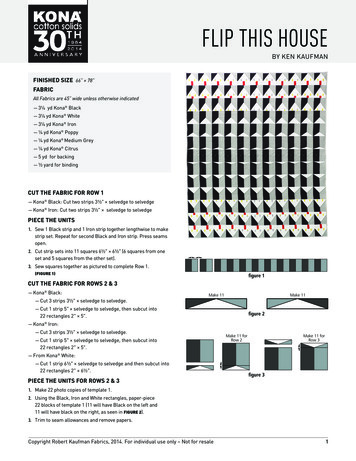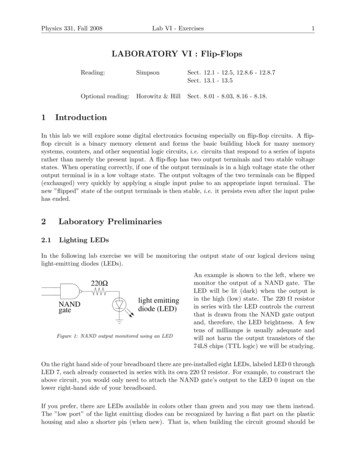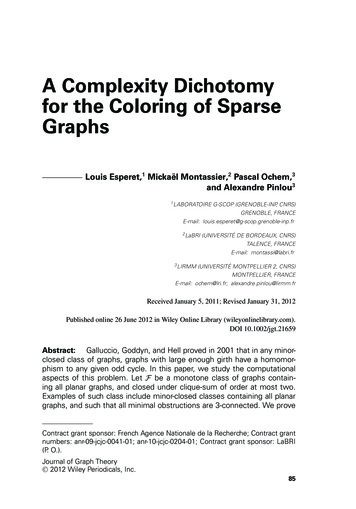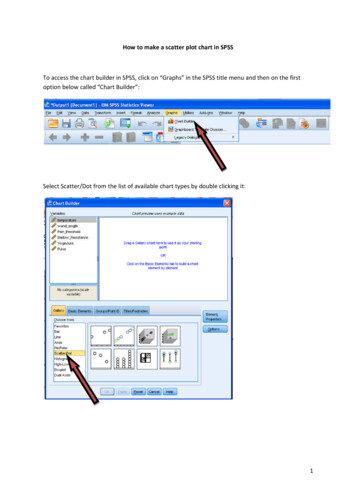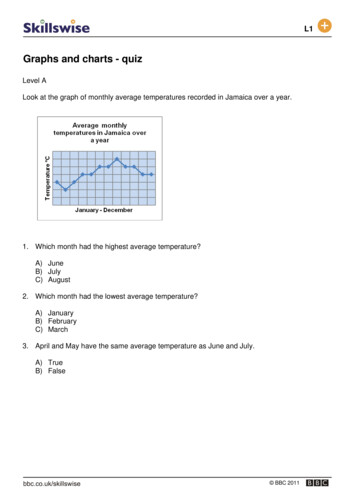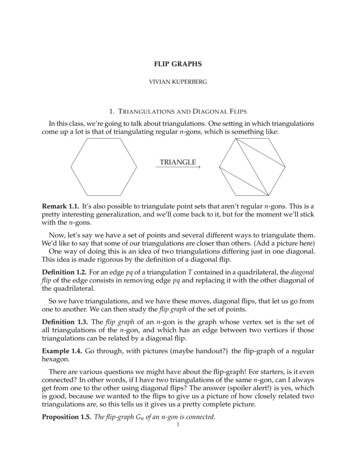
Transcription
FLIP GRAPHSVIVIAN KUPERBERG1. T RIANGULATIONS AND D IAGONAL F LIPSIn this class, we’re going to talk about triangulations. One setting in which triangulationscome up a lot is that of triangulating regular n-gons, which is something like:TRIANGLERemark 1.1. It’s also possible to triangulate point sets that aren’t regular n-gons. This is apretty interesting generalization, and we’ll come back to it, but for the moment we’ll stickwith the n-gons.Now, let’s say we have a set of points and several different ways to triangulate them.We’d like to say that some of our triangulations are closer than others. (Add a picture here)One way of doing this is an idea of two triangulations differing just in one diagonal.This idea is made rigorous by the definition of a diagonal flip.Definition 1.2. For an edge pq of a triangulation T contained in a quadrilateral, the diagonalflip of the edge consists in removing edge pq and replacing it with the other diagonal ofthe quadrilateral.So we have triangulations, and we have these moves, diagonal flips, that let us go fromone to another. We can then study the flip graph of the set of points.Definition 1.3. The flip graph of an n-gon is the graph whose vertex set is the set ofall triangulations of the n-gon, and which has an edge between two vertices if thosetriangulations can be related by a diagonal flip.Example 1.4. Go through, with pictures (maybe handout?) the flip-graph of a regularhexagon.There are various questions we might have about the flip-graph! For starters, is it evenconnected? In other words, if I have two triangulations of the same n-gon, can I alwaysget from one to the other using diagonal flips? The answer (spoiler alert!) is yes, whichis good, because we wanted to the flips to give us a picture of how closely related twotriangulations are, so this tells us it gives us a pretty complete picture.Proposition 1.5. The flip-graph Gn of an n-gon is connected.1
2VIVIAN KUPERBERGProof. Let’s number our vertices counterclockwise by 0, 1, . . . , n 1. We’ll show that anytriangulation T is connected via diagonal flips to the triangulation F, a fan at 0, whereevery diagonal is through 0. Then we can connect any two triangulations T and S by goingthrough our process to get from T to F, and then backwards to get from F to S.Let T 6 F be any triangulation of the n-gon. Consider the points connected to 0 viadiagonals in T. This must include 1 and n 1 via outside edges, so it’s some nontrivialsubset S {1, . . . , n 1}. If every vertex is connected to 0, then T would be F, which isnot the case. Thus some vertex 1 j n 1 is missing. Let i j be the largest vertexbefore j that is connected to 0, and let k j be the smallest vertex after j that is connectedto 0. Then (i, 0, j) must form a triangle in our triangulation, so (i, j) is a diagonal of T.Flipping (i, j) gives one more diagonal through 0.In particular, this argument shows that for any triangulation T with fewer than n 1diagonals through 0, a diagonal flip can be performed that will increase the number ofdiagonals through 0. We can keep performing this process until it terminates, which mustbe when we have reached F via diagonal flips. Remark 1.6. Here is one fun application (working out the details is a good homeworkquestion).If we have an associative product operation · and some product x0 · x1 · · · · · xn , weusually say that we feel comfortable not writing parentheses by associativity. But associativity only tells us that when multiplying three things a, b, and c, a(bc) ( ab)c. Howdo we know that any parenthesization of x0 , . . . , xn is equivalent? There’s a correspondence between parenthesizations of x0 , . . . , xn and triangulations of an (n 2)-gon (bothof which are examples of things counted by Catalan numbers). It turns out that performingone operation of the associativity law exactly corresponds to doing a diagonal flip. So theargument that the flip graph is connected is exactly what tells us that associativity of threethings is enough to never worry about parentheses.So, now that we know that the flip-graph is connected, a next question is its diameter.What’s the largest possible flip distance between two triangulations of an n-gon? This isknown as the diameter of Gn .Theorem 1.7. The diameter Dn of Gn satisfiesDn 2n 10 b12c.nProof. Just like our proof above with connectivity, this proof relies on flipping to and fromstar triangulations, where all diagonals go through one vertex.Let T1 and T2 be two triangulations of an n-gon. For a point x on our n-gon, the degreed1 ( x ) is the number of diagonals incident to x in T1 , and analogously with d2 and T2 . Fori 1, 2, if di ( x ) n 3, then as in our previous argument the degree of x can be increasedby an appropriate flip on Ti . The number of flips required to get from Ti to Sx , the starthrough x, is n 3 di ( x ), based on just counting diagonals through Sx . Thus going fromT1 to T2 through Sx takes 2n 6 d1 ( x ) d2 ( x ) flips. Thus, the distance from T1 to T2 isbounded above byDn min(2n 6 d1 ( x ) d2 ( x )) 2n 6 max(d1 ( x ) d2 ( x )).xx
FLIP GRAPHS3So we’d like to find a lower bound on maxx (d1 ( x ) d2 ( x )) in order to get an upper boundon Dn . We can get this from taking an average of d1 ( x ) d2 ( x ) over all x. The sum of alldegrees is twice the number of diagonals, which is n 3, so d1 (x) d2 (x) 2n 6 2n 6xx11 (d1 ( x ) d2 ( x )) (4n 12).n xnSome vertex x must have an above average value of d1 ( x ) d2 ( x ), so maxx (d1 ( x ) d2 ( x )) 4 b 12n c. ThusDn 2n 6 max(d1 ( x ) d2 ( x )) 2n 6 4 bxwhich is the desired result.12c,n So now the question is, is this bound tight? It seems like we didn’t do very much work.Also, we guessed a silly way to get from one triangulation to another. If the bound is tight,we’re saying that for some triangulations, this silly way is the best possible. However,the bound is indeed tight for n 18. For n 8, this is doable by hand (hw problem?).Surprisingly enough, the bound of 2n 10 is also known to be tight for certain large valuesof n (and in particular, infinitely often). The proof uses some hyperbolic geometry (nokidding!) and gets a bit gnarly, but we’ll spend the next day or two going over an outline.2. F ROM T RIANGULATIONS TO P OLYTOPESWe’ll be working through an outline of the following result.Theorem 2.1. For large enough n, the diameter Dn of the flip-graph Gn is 2n 10. In particular,Dn 2n 10.We begin by the observation that if T1 and T2 are a pair of triangulations maximizing theflip-distance dist( T1 , T2 ), then they must have no diagonal in common. There can never bea reason for a common diagonal to be flipped, so if T1 and T2 shared a diagonal, we couldflip a shared diagonal in T1 to get T10 and T2 , that are at least one more step away from eachother. From now on, let T1 and T2 be a pair of triangulations with no shared diagonals.We’re then going to construct a tetrahedrated polyhedron from a flip path from T1 to T2as follows. (Draw draw draw draaaaw here picture with hexagon and tiles). We’re goingto glue the two triangulations T1 and T2 along their boundary to create a decoration onthe boundary of a sphere. Now, each flip is going to become a tetrahedron. How? Well,the flip operation consists of taking a parallelogram containing a diagonal. Then we canimagine drawing the old diagonal faintly (’cause it’s old), and the new diagonal firmly ontop.and hey, we’ve just drawn a tetrahedron!So, we have a base tiling T1 . Then every flip is a tetrahedral tile we can glue on theprevious tetrahedron. At every step, all faces have to perfectly match up. When we reachT2 , we glue on the triangulation T2 as the top face. Since T1 and T2 share no diagonals,Then we can imagine inflating our flat picture like a beach ball to get this polyhedron filledwith tetrahedra. Let PG be this polyhedron.
4VIVIAN KUPERBERGBlack Box 2.2. If we inflate the ball so that all the tetrahedra are convex, we get somethingwith rigid edges that looks like a polyhedron. In fact, this is always a convex polyhedron.Assume that our flip sequence consists of t flips, with tetrahedra τ1 , . . . , τt correspondingto each flip. Thentvol( PG ) vol(τi ).i 1OK, so we want a lower bound on the number t of tetrahedra in our path. If we knewthat some value V were an upper bound on the volume of a tetrahedron that can beinscribed in the polytope PG , then we’d havetvol( PG ) V ,i 1implying thatvol( PG ),V which would give us exactly the kind of bound we want. However, at the moment thisseems pretty bad. We don’t know what our polytope in R3 really looks like, and we couldhypothetically inscribe a big tetrahedron that would have volume close to that of PG itself.In that case, this would say that t 1, which is not very helpful.By one interpretation, the problem that we’re running up against is that in Euclideangeometry, we can’t bound the volume of tetrahedra very well. So, why don’t we switch toworking in a geometry where we can?t 3. H YPERBOLIC G EOMETRYClassically, the idea behind hyperbolic geometry is as follows. Instead of taking theaxiom, as we do in Euclidean geometry, that given a line and a point not on the line, thereexists exactly one line through the point parallel to the given line, we take the axiom thatthere are many lines through the point parallel to the given line. This leads to lots ofstrange properties! For example, and what we most need, triangles in hyperbolic 2-spaceand tetrahedra in hyperbolic 3-space have uniformly bounded volume, i.e. I can tell you anumber c such that you cannot draw a triangle or a tetrahedron in hyperbolic space withvolume greater than c. For tetrahedra, we won’t prove this fact, but let’s look a little bit athow hyperbolic space works in two dimensions, to give us an idea of why this might betrue. There are many ways to model hyperbolic space; let’s start with the Poincaré disk.facts about hyperbolic space: Poincaré disk model, intuition that triangles have boundedvolume, mention that optimal triangles have points on the sphere at infinity, half-spacemodel and equivalence, discuss the point at infinity (TODO put this in)So at this point, the goal becomes to construct a hyperbolic polyhedron whose boundaryconsists of gluing two triangulations T1 and T2 just like our PG above, and which has largevolume. Then we know that if we built a flip path from T1 to T2 , it would need someminimum number of flips because we need a minimum number of tetrahedra. Again,we’re going to simplify things a bit. With a fairly straightforward construction, we can dopretty well. If you make the construction significantly uglier and more complicated, youcan get the actual bound - if you’re excited about that, talk to me at TAU!
FLIP GRAPHS5Proposition 3.1. For k N and n k2 1, there are triangulations T1 , T2 of an n-gon with flipdistance dist( T1 , T2 ) 2n 4 n O(1).Proof. Consider the section of the triangular grid below.For parallelogram sidelength k, this has k2 1 points. We can fill it with ideal tetrahedra,with each tetrahedron having one vertex at v and base one triangle in our grid. There are2(k 1)2 of these triangles in the grid, so the volume of this polytope is 2(k 1)2 V0 , withV0 the maximal volume of a tetrahedron in hyperbolic space.22Thus every way to fill this polytope with tetrahedra requires at least 2(k 1) 2k 4k 2 2n 4 n O(1) tetrahedra. This is exactly what we want if we can show thatthere exist T1 , T2 triangulations such that the polytope above is the flip polytope from oneto the other.But to do this, we really need to draw a Hamiltonian cycle, or a path going through allvertices exactly once, then joining to its end. As one example, we can zigzag through thegrid, then connect to and from v at the end. This cycle has two sides, an “outside” andan “inside,” each of which is one triangulation, just as desired. With a different, more complicated choice of polytope, one can prove:Theorem 3.2 (Sleator, Tarjan, Thurston). For sufficiently large n, the diameter of the flip-graphof an n-gon is 2n 10.Their polytopes are constructions based on subdividing faces of an icosahedron (drawa picture), then sometimes cutting out faces to get the right number n of vertices (drawa minipicture of this too). They then show that the tetrahedralization of these polytopesrequiring the least number of tetrahedra is of cone type, so it must have 2n 10 idealizedtetrahedra, so this is an appropriate large hyperbolic polytope.This concludes our sketched discussion. We wanted to provide a lower bound on thediameter of the flip-graph, and our strategy, surprisingly enough, consisted of takingthe problem up a dimension by making tetrahedrated polyhedra out of a path in the
6VIVIAN KUPERBERGflip-graph, then translating the problem once again to hyperbolic geometry so that wecould use volume bounds, then finding special hyperbolic polyhedra that reached thebounds correctly. Whew!4. A RBITRARY POINTSETSOkay, but let’s say we’ve decided now that we’re really good at triangulating n-gons,and we want to triangulate an arbitrary finite set of points P in the plane. We’ll assumethat P is a “general” set of points, which basically means that if we encounter problemsbecause the points are arranged in a very specific configuration, we can assume thatthat configuration doesn’t occur. For example, if P is a set of colinear points, we cannottriangulate P , but if you randomly pick points in the plane, it would be very surprising ifthey were colinear, so we will assume that this is not the case. Similarly, we’ll assume thatno four of our points lie on a circle.Definition 4.1. A triangulation of a set of points P in the plane is a maximal non-crossinggeometric graph with vertex set P . In other words, it is a set of line segments betweenpoints of P so that no two lines cross and we can’t add any more
FLIP GRAPHS VIVIAN KUPERBERG 1. TRIANGULATIONS AND DIAGONAL FLIPS In this class, we’re going to talk about triangulations. One setting in which triangulations come up a lot is that of triangulating regular n-gons, which is something like: TRIANGLE Remark 1.1. It’s also possible to triangulate point sets that aren’t regular n-gons. This is a pretty interesting generalization, and we’ll .

